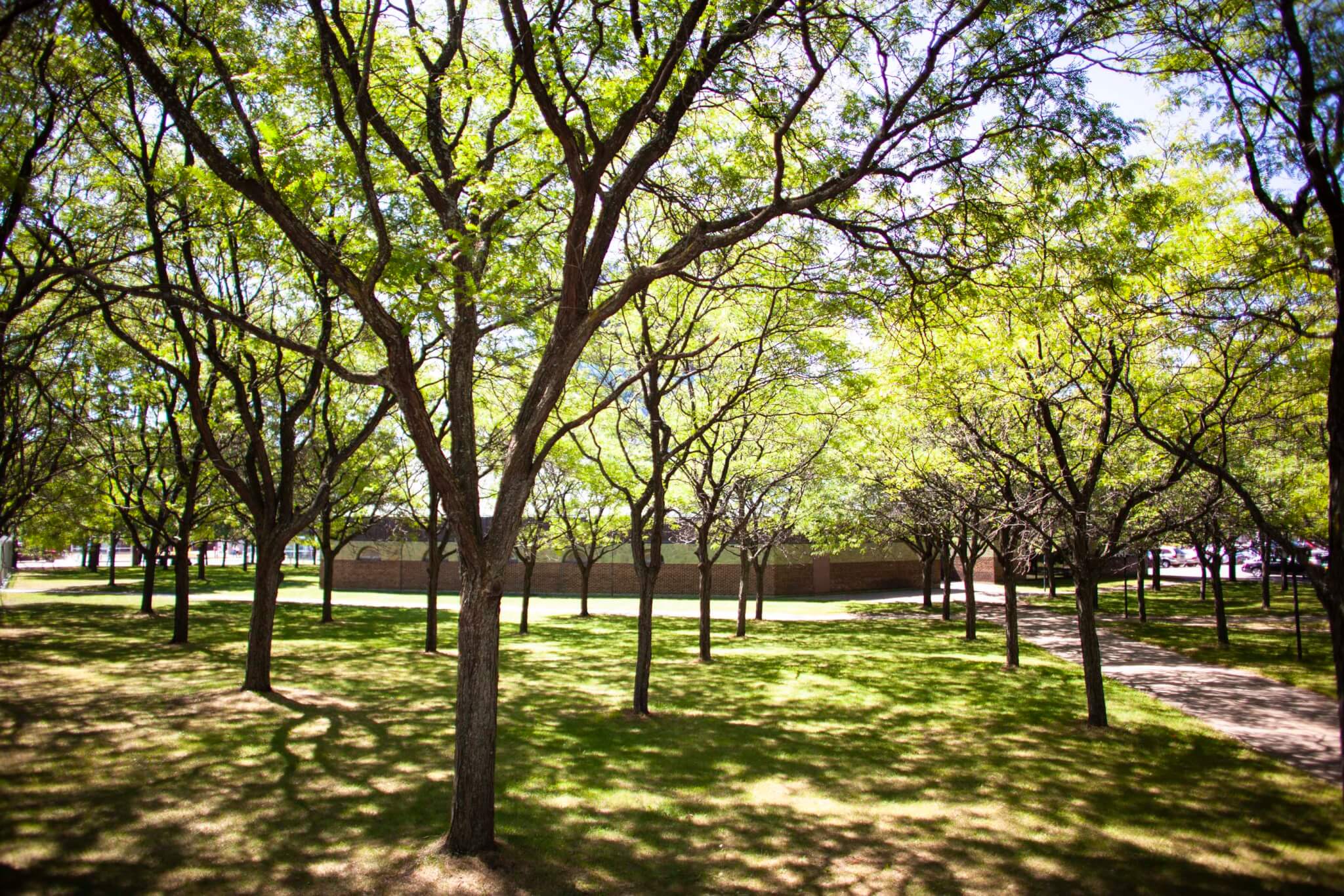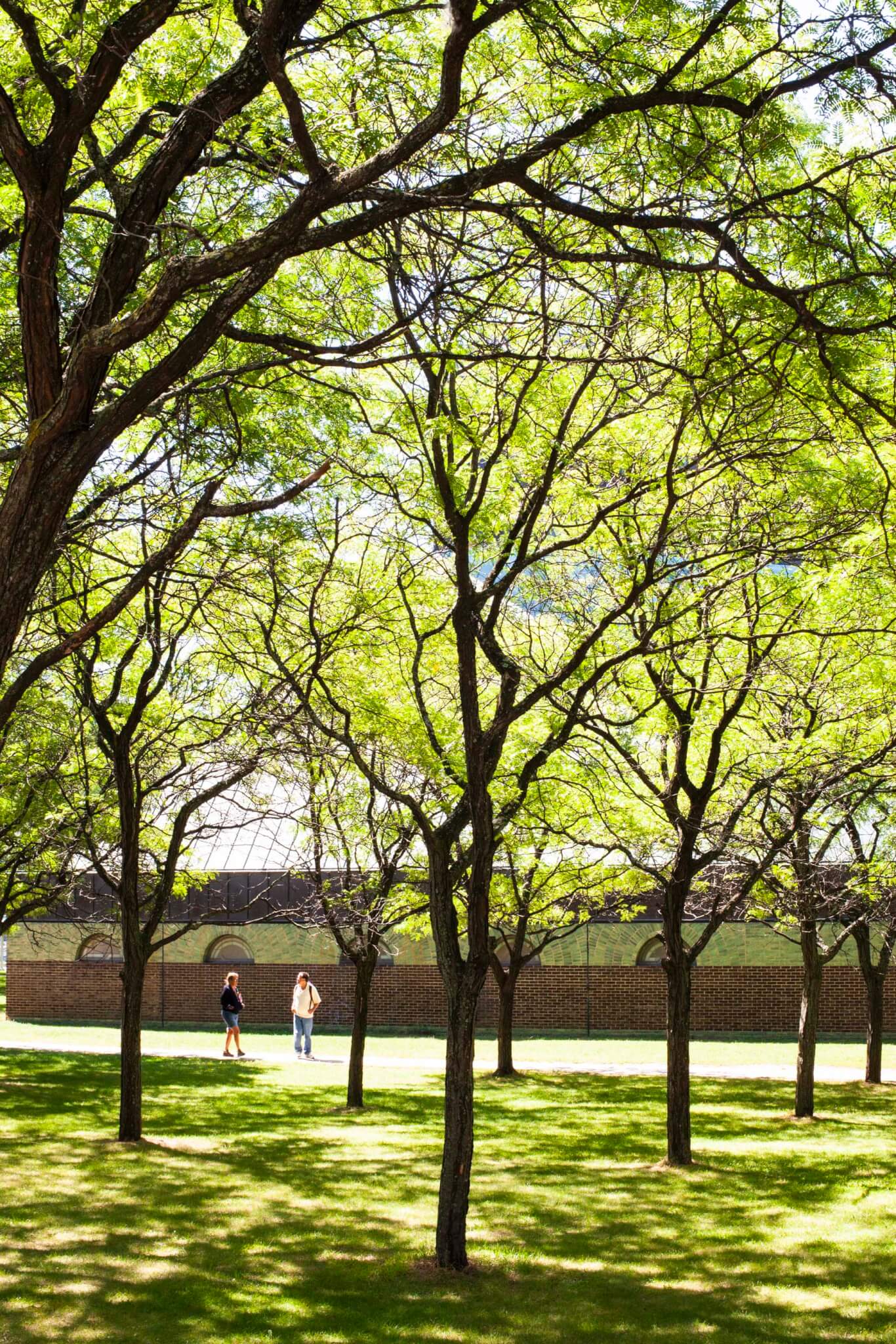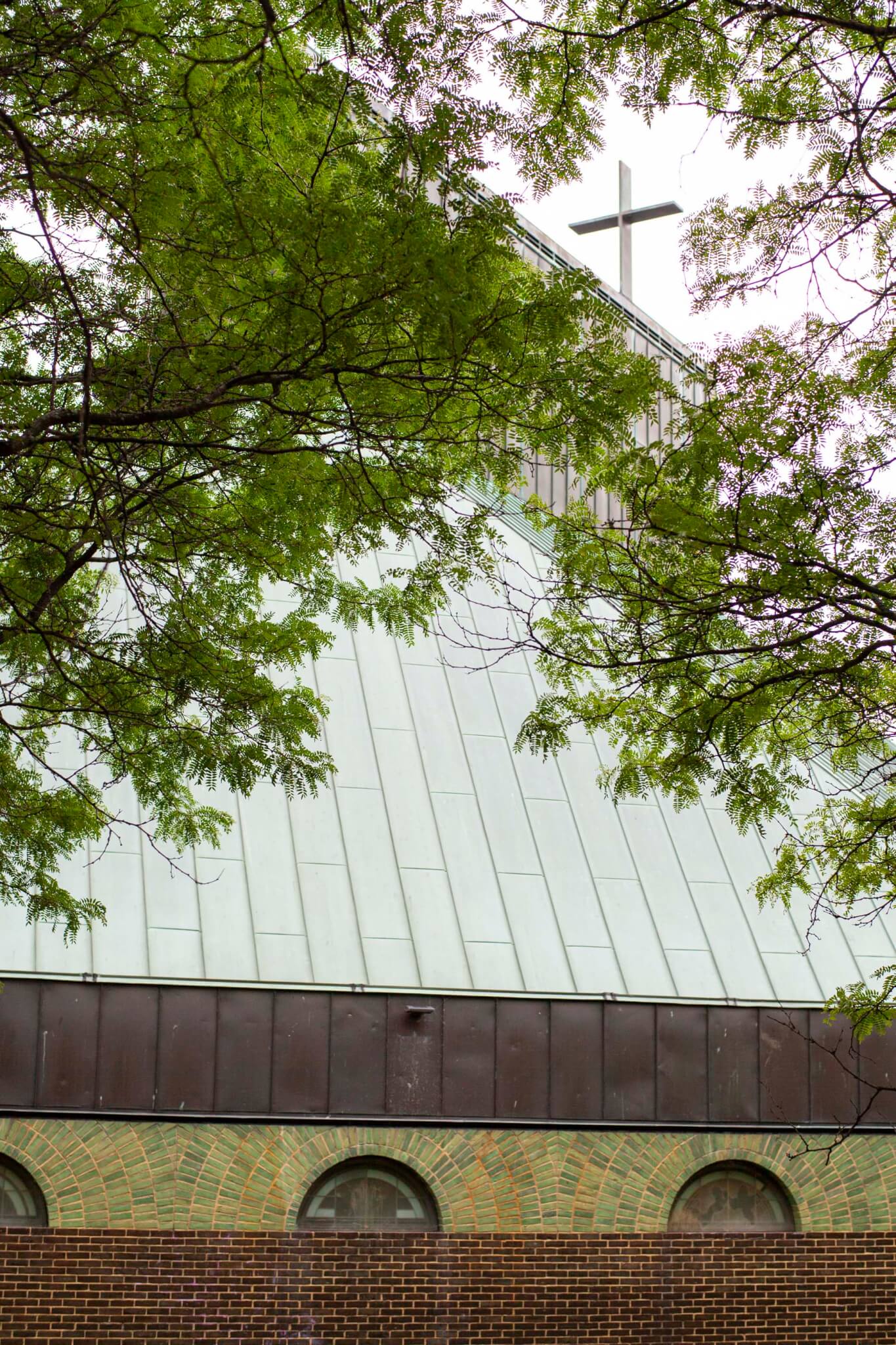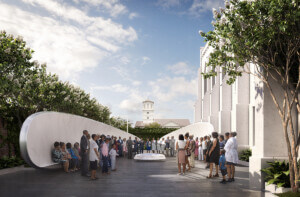An Edward Larrabee Barnes and Dan Kiley collaboration stands in the center of Burlington, Vermont—but it might not for much longer. The former Catholic Cathedral of the Immaculate Conception, completed in 1977, has sat unused since 2018. Since then, it’s been surrounded by chain link fence and remains in active danger of demolition.
Barnes and Kiley were repeat collaborators, with Kiley designing landscapes alongside Barnes work at the Dallas Museum of Art, Scaife Galleries at the Carnegie Museum in Pittsburgh, and elsewhere. They took a spiritual turn on this project, a new cathedral for the Catholic diocese of Burlington, which replaced the previous Gothic Revival structure that was destroyed by fire in 1972.
Devin Colman, the state architectural historian of Vermont, explained its unique qualities to AN: “This is one of the very few if not the only modernist property in the state in which we have two world-renowned designers, Kiley and Barnes, working together on the same project. It’s not a case of designing a building and then adding the landscaping. The landscape reinforces the design of the building, and the building reinforces the landscape. You really can’t have one without the other.”
It’s also one of few non-residential projects that Kiley, who resided and worked in nearby Charlotte for forty years, carried out in Vermont (Another local project was completed for the University of Vermont in the early 1970s). The cathedral is surrounded by Kiley’s bosque of honey locust trees. It’s a tranquil spot, but it’s unclear for how much longer.
A dwindling congregation rendered the Diocese unable to support the property, which lead to the decision to sell the property—currently listed for $8.5 million. As for its future, Monsignor Peter Rothier wrote, “There are really no answers to your questions at this time.” Donahue & Associates, who are handling the possible sale, did not respond to inquiries. Their listing notes that “the offering will provide a buyer with the opportunity to continue to utilize the existing building or develop a project that suits the Burlington market and landscape.”
The most recent scare arose in December, when Donahue & Associates filed a demolition permit with the city. Colman explained “The permit application was rejected as incomplete because the city wanted an indication of plans for the site, and there weren’t any. A comprehensive redevelopment plan has yet to be presented for review by the city. “Since then, it’s been a waiting game to see if and when they put out a redevelopment plan.”

The project offers an elegant accord of built and planted elements and involved a number of notable talents beyond Barnes and Kiley. Toshiko Mori, founder of Toshiko Mori Architect and Vision Arc and Robert P. Hubbard Professor in the Practice of Architecture at the Harvard Graduate School of Design, worked on interiors and furniture design at Barnes’s office. “He used local Vermont stone for the floor and local white oak for pews to make sure the material related to its own community,” she said. “There are a series of stained glass windows which are geometric and abstract without a lot of religious connotations. Yes, it is a sacred space made for the Catholic faith, but I think it is conceived with a wish for more inclusive use in future.”
The absence of many explicit religious elements would seem a boon to possibilities for reuse as a theater or some sort of performance venue. Mori continued: “Ed conceived it more like a meeting house instead of a cathedral. So that it can easily be converted into a place for community meetings, various performances, music or play or reading that can welcome people of diverse faiths and backgrounds. “
The property was Vermont-scaled from the start, with seating for 450, and reflects one of Barnes’s numerous meldings of angular geometry with vernacular New England nods. Colman noted, “He looked really closely at Burlington and especially H.H. Richardson’s Billings Library.”
The exterior features horizontal bands of brown and green brick (with semi-circular windows inset in the upper layer) and a copper roof.
That roof required a considerable amount of thought, consisting of a gabled portion leading to a sort of spire topped with a skylight: a series of downward stresses without columns to help. Demetri Sarantitis, who was Project Architect on the job, recalled in conversation, “with all of that put together it wants to collapse.” Additional vertical beams or horizontal supports could have solved this issue, but “destroyed the purity of the space.” Engineering wizard Robert Silman devised an “enormously complicated steel structure” to keep this all aloft.
Saranitis also designed a free-standing Cor-ten bell tower on the property, “the one thing that I had full freedom on was the bell tower. I designed it independently; Ed was great about things like that.”
Colman observed, “It’s not a big giant cathedral; it’s very modest. When you walk inside there’s a subtle play of spaces. Step by step you decompress and you can have your religious experience.” Trademark state shades continue with a green slate altar and floors.
Unusual and skillful fenestration was a Barnes trademark, and it remains so here, with light entering from its skylight and multiple stained glass elements. Robert Sowers, who worked on the former American Airlines terminal at JFK airport, designed a stained glass Jerusalem cross set into a wall. David Wilson designed the ten stained glass windows lining the apse.
Wilson explained that Robert Sowers was originally slated to design all of the windows but could not. Wilson knew Alastair Bevington at Barnes’s office, who arranged an interview with Ed and Mary Barnes. “You think you’re going to meet this big-time architect, but he and Mary were actually wonderful normal people.”
The windows include “pearly” white glass “referred to as opal glass either made by Lamberts in Germany or Verrerie Saint-Just in France” and a transparent green band. “A friend of mine once called them the protractor series,” Wilson said.

Wilson recalled the era fondly. “Up to that time Catholic churches were built to a sort of medieval pattern. With Vatican II they tried to make the altar more central in the planning. It really was not just stained glass it was the whole interior and everything all around it. It was a wonderful period really. It’s sort of gone backwards since.”
The parish’s origin rests with Quebecois immigrants, a legacy continued with a pipe organ built by Casavant Frères of Saint-Hyacinthe, Quebec. Bevington designed an ornamental oak enclosure for the organ, located directly behind the altar.
Peter Ker Walker, who worked with Kiley until 1986 when he launched his own practice, worked on the garden design, a swath of honey locust trees set on a 20-foot grid amid grass. The honey locust was a favorite in Kiley’s arboreal quiver and can be found in his designs at the Miller House in Columbus, the Carnegie Museum courtyard in Pittsburgh, and numerous other projects. Lithe and sinuous, honey locusts provided reliably sculptural contrast to any number of highly geometric buildings.
Walker explained in conversation that “the quality of the topsoil was very poor.” One tree sank into the ground after planting. Things did not improve subsequently. Walker continued, “I think the diocese was totally neglectful. The diocese never came back to us with any questions after the completion of the installation.” Trees close to the building were removed due to their utility as ladders for climbing onto the church roof. He was called for advice when an adjacent city bus station was expanded, which required the removal of one row of trees. The City of Burlington funded some much-needed garden touchups, with trees from that row replanted in spots where others had died, and some other maintenance undertaken.
The garden is unkempt today, as a recent stroll around the property confirmed. Colman also noted reports that interior fixtures and furnishings have been removed, with some items for sale at a local salvage shop. Visibility remains an issue, as “a lot of people in Burlington are not aware of the building” said Colman. Burlington Associates’ Episcopal Cathedral of St Paul, a Brutalist church two blocks away, remains in use, a rare concentration of religious modernism for a small city.
Celina Barton, founder of the Barton Group and a licensed real estate broker has been seeking to facilitate some adaptive reuse of the space. She indicated that she has a qualified buyer interested in purchasing the property, but was denied access. “This national treasure designed by two masters: Edward Larrabee Barnes and Dan Kiley remains the heart and lungs of the City and deserves to be saved as a community asset.”

Barton said that “the building and garden were intended to be a gift and rebirth to the community. We believe they are too significant as objects and as markers of our history and our shared community. We welcome the Catholic Church as a partner—what a wonderful opportunity for Vermont to lead with this little cathedral on the hill surrounded by the gardens of Dan Kiley.”
Docomomo USA and The Cultural Landscape Foundation have also pointed out these extant risks and encouraged adaptive reuse. Preservation Burlington has set up a site showcasing the complex.
“Fifty years after the mother church of the Roman Catholic Diocese of Vermont burned down, its replacement, a celebrated Modernist gem designed by architect Edward Larrabee Barnes paired with its elegant 1.2-acre setting by Vermont’s own Dan Kiley, one of the nation’s most influential postwar landscape architects, is in mortal danger,” said Charles A. Birnbaum, President and CEO of The Cultural Landscape Foundation. “The loss of this rare Vermont commission by Kiley would be tragic and unnecessary.”
Liz Waytkus, executive director of Docomomo USA observed, “Docomomo US has been following the deconsecration and sale of Burlington’s Immaculate Conception Church for at least the last five years. The issue of declining religious populations and the inability to care for these sites is a national problem with few solutions. The Barnes–Kiley design is wonderful and represents modernism at its best with a seamless integration of aesthetics, technology, setting, and society.”
Anthony Paletta is a freelance writer in New York City. He has contributed to The Wall Street Journal, The Guardian, Metropolis, Architectural Record, CityLab, and other publications.











